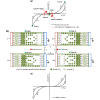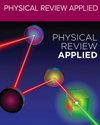Transport properties of interface-type analog memristors
IF 4.4
2区 物理与天体物理
Q2 PHYSICS, APPLIED
引用次数: 0
Abstract
Interface-type, analog memristors have quite a reputation for real-time applications in edge sensorics, edge computing, and neuromorphic computing. The n-type conducting (BFO) is such an interface-type, analog memristor, which is also nonlinear and can therefore not only store, but also process data in the same memristor cell without data transfer between the data-storage unit and the data-processing unit. Here we present a physical memristor model, which describes the hysteretic current-voltage curves of the BFO memristor in the small and large current-voltage range. Extracted internal state variables are reconfigured by the ion drift in the two write branches and are determining the electron transport in the two read branches. Simulation of electronic circuits with the BFO interface-type, analog memristors was not possible so far because previous physical memristor models have not captured the full range of internal state variables. We show quantitative agreement between modeled and experimental current-voltage curves exemplarily of three different BFO memristors in the small and large current-voltage ranges. Extracted dynamic and static internal state variables in the two full write branches and in the two full read branches, respectively, can be used for simulating electronic circuits with BFO memristors, e.g., in edge sensorics, edge computing, and neuromorphic computing.

界面型模拟忆阻器的传输特性
接口型模拟忆阻器在边缘传感、边缘计算和神经形态计算的实时应用中享有盛誉。n 型导电 BiFeO3(BFO)就是这样一种界面型模拟忆阻器,它也是非线性的,因此不仅可以存储数据,还可以在同一忆阻器单元中处理数据,而无需在数据存储单元和数据处理单元之间进行数据传输。在这里,我们提出了一个物理忆阻器模型,该模型描述了 BFO 忆阻器在小电流和大电流-电压范围内的滞后电流-电压曲线。提取的内部状态变量在两个写入分支中由离子漂移重新配置,并在两个读取分支中决定电子传输。由于以往的物理忆阻器模型无法捕捉全部内部状态变量,因此迄今为止还无法利用 BFO 接口型模拟忆阻器模拟电子电路。我们以三种不同的 BFO 回忆晶体管为例,展示了在小电流和大电流-电压范围内,模型与实验电流-电压曲线之间的定量一致性。在两个全写分支和两个全读分支中分别提取的动态和静态内部状态变量可用于模拟带有 BFO Memristors 的电子电路,例如边缘传感、边缘计算和神经形态计算。
本文章由计算机程序翻译,如有差异,请以英文原文为准。
求助全文
约1分钟内获得全文
求助全文
来源期刊

Physical Review Applied
PHYSICS, APPLIED-
CiteScore
7.80
自引率
8.70%
发文量
760
审稿时长
2.5 months
期刊介绍:
Physical Review Applied (PRApplied) publishes high-quality papers that bridge the gap between engineering and physics, and between current and future technologies. PRApplied welcomes papers from both the engineering and physics communities, in academia and industry.
PRApplied focuses on topics including:
Biophysics, bioelectronics, and biomedical engineering,
Device physics,
Electronics,
Technology to harvest, store, and transmit energy, focusing on renewable energy technologies,
Geophysics and space science,
Industrial physics,
Magnetism and spintronics,
Metamaterials,
Microfluidics,
Nonlinear dynamics and pattern formation in natural or manufactured systems,
Nanoscience and nanotechnology,
Optics, optoelectronics, photonics, and photonic devices,
Quantum information processing, both algorithms and hardware,
Soft matter physics, including granular and complex fluids and active matter.
 求助内容:
求助内容: 应助结果提醒方式:
应助结果提醒方式:


